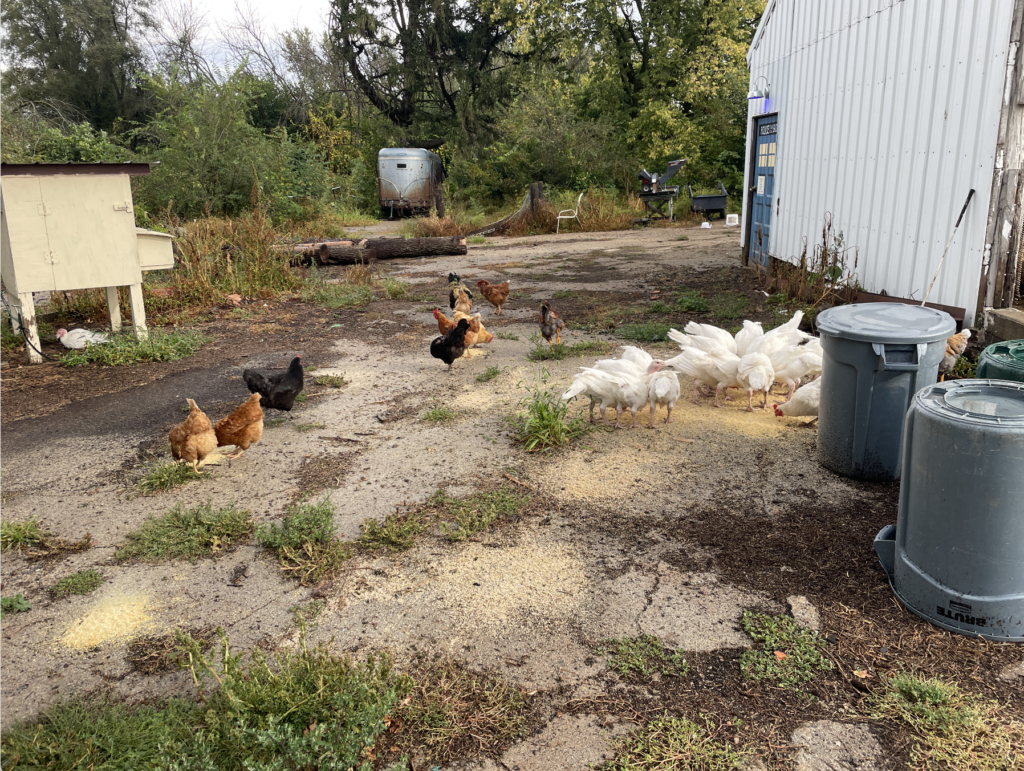
Turkeys and chickens munch on some feed outside at Uncle G’s Farm in Ogden, Iowa. (Photo contributed by Garin Buttermore)
Turkey is the star of the Thanksgiving table. It’s the highest-dollar item and, in many houses, the most sought-after leftover.
But this year, fewer turkeys were produced in the U.S. and because of decreased demand, the wholesale cost per pound of turkey dropped to below $1 for the first time since 2019.
The turkey industry in Iowa accounts for 38,000 jobs and $10.6 billion in economic activity, according to the Iowa Turkey Federation, which makes Iowa one of the top turkey-producing states in the country, annually raising about 12 million turkeys and processing over 15 million birds.
“As Iowans gather around the table this Thanksgiving, I encourage you to think about the farmers that made that meal possible and the work they do every single day,” Iowa Secretary of Agriculture Mike Naig said in a Monday press release celebrating a “virtually complete” harvest season.
“We have much to be thankful for here in Iowa. We are truly blessed to live in the greatest state in the greatest nation, and to be a part of Iowa agriculture.”
Nationally, the production of turkey was down this year from last, with just 5.11 billion pounds produced, compared to 5.5 billion pounds in 2023, according to U.S. Department of Agriculture data from January through September. Overall production has been trending down since 2017, according to USDA.
The American Farm Bureau, in its annual Thanksgiving dinner cost survey, blamed the highly pathogenic avian influenza, which according to the bureau has affected over 14 million turkeys since 2022. It also said decreased demand has led to lower cost per pound of the birds.
The United States is the largest turkey producer in the world, and USDA data shows the majority of turkey produced in the U.S. is consumed in the country, with just 400-600 million pounds exported annually.
Thanksgiving dinner cost is down
According to the American Farm Bureau’s Thanksgiving dinner cost survey, the average cost of the meal, for 10 people, is 5% lower this year than last year, with an average cost-per-plate of $5.80.
But, the survey found that while prices have been declining since a peak in 2022 when the meal cost $6.40 per plate, costs this year are 19% higher than 2019, the Thanksgiving before the COVID-19 pandemic let to spiking inflation.
Cranberries and packaged food, like rolls and stuffing, had the largest increases in cost, 12% and 8% respectively, according to the survey results.
Just over 40% of the cost each year goes to turkey.
USDA data shows 2024 as the first year since the pandemic that average turkey prices per pound dropped below $1, now at 94 cents per pound in a wholesale market. That’s down quite a bit from the peak of $1.55 per pound in 2022.
Consumers who sourced a turkey outside of the grocery store this year, however, likely spent quite a bit more.

A pastured bird from a small local farmer runs between $5 and $7 a pound in Iowa, which significantly raises the cost-per-plate at a Thanksgiving gathering.
Garin Buttermore, or “Uncle G” of Uncle G’s Farm in Ogden, jumped back into selling turkey this year after several on and off years. He said he likes to raise the birds alongside his free-range chicken, but had been unable to find a local processor to take his birds until recently.
Buttermore and his wife run a small farm and homestead on land he purchased from his family. They raise pork and chicken with what they call “sustainable practices” meaning the birds peck at the grass and eat bugs, pigs are in an open barn and neither are given routine antibiotics or hormones, according to their website.
“We raise a product that you can’t find at the store,” Buttermore said.
This year he raised and sold 16 turkeys, all between 11 and 17 pounds, which he has found to be the best size for his customers.
As soon as they’re out of the brooder, Buttermore said the turkeys are free to roam around his seven-acre property or glean the harvested corn and soybean fields nearby until it’s time to dispatch and take them to the processor.
“The turkeys being able to go and do the things that turkeys do … definitely is a better end product,” Buttermore said.
Buttermore sold his birds for $5.50 a pound and said he easily sold out.
“The folks that buy from us are expecting high quality, because they’re definitely not cheap, and I aim to give it to them,” Buttermore said.
All told, he gets more than $1 per pound back on each bird, which is significantly more than what many conventional farmers make, according to the National Farmers Union.
The union’s annual “Farmer’s Share of the Food Dollar” report for Thanksgiving shows a farmer gets 6 cents per pound back on a Butterball frozen turkey that retails for $2.42 per pound.
Buttermore said he hopes his customers “can taste that difference.”
“The quality of life for the birds is just bonus,” Garin said.
Turkeys don’t yield a huge profit for him, in fact most of the meat he sells just goes into powering the farm, “and honestly to let some people have some awesome food.”
“Hopefully we’ll just keep expanding,” Buttermore said, noting he aims to raise more turkeys next year. “And giving more Iowans amazing turkey.”
YOU MAKE OUR WORK POSSIBLE.

